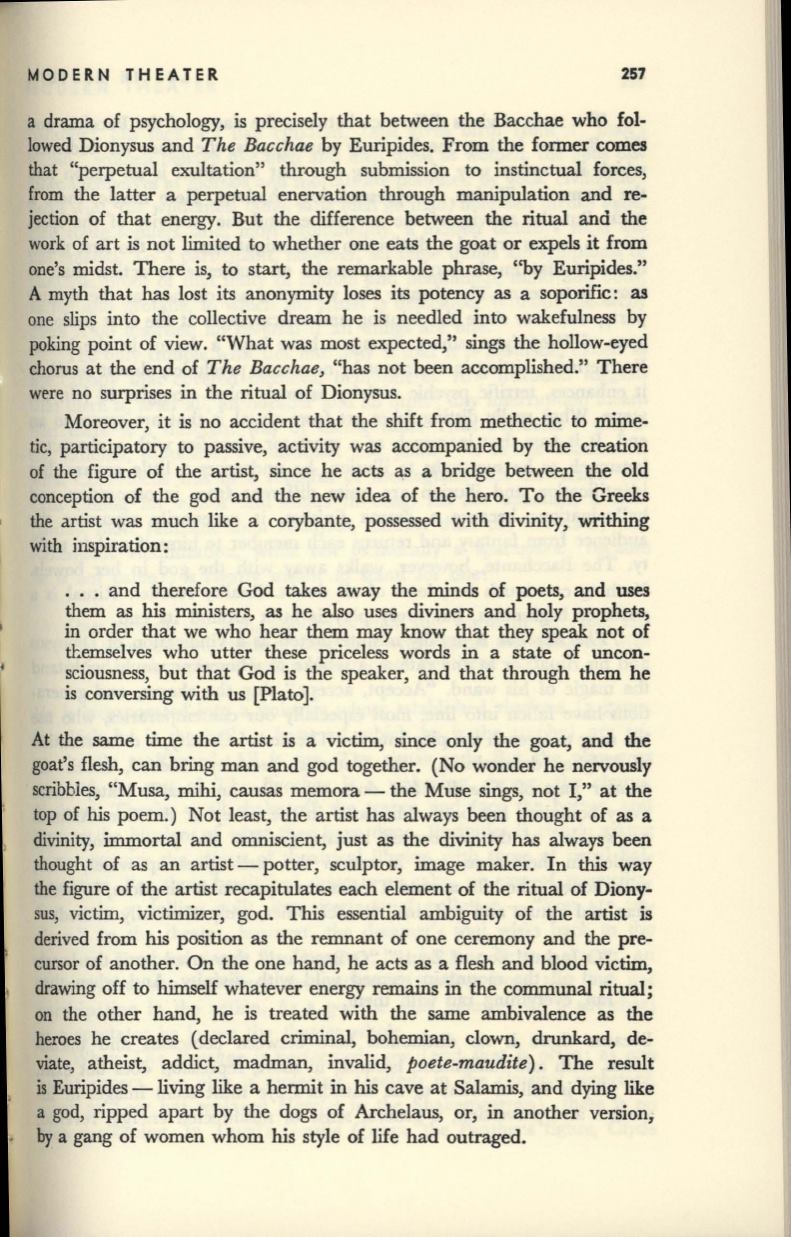
MODERN THEATER
257
a drama of psychology, is precisely that between the Bacchae who fol–
lowed Dionysus and
The Bacchae
by Euripides. From the former comes
that "perpetual exultation" through submission to instinctual forces,
from the latter a perpetual enervation through manipulation and re–
jection of that energy. But the difference between the ritual and the
work of art is not limited to whether one eats the goat or expels it from
one's midst. There is, to start, the remarkable phrase, "by Euripides."
A myth that has lost its anonymity loses its potency as a soporific: as
one slips into the collective dream he is needled into wakefulness by
poking point of view. "What was most expected," sings the hollow-eyed
chorus at the end of
The Bacchae,
"has not been accomplished." There
were no surprises in the ritual of Dionysus.
Moreover, it is no accident that the shift from methectic to mime–
tic, participatory to passive, activity was accompanied by the creation
of the figure of the artist, since he acts as a bridge between the old
conception of the god and the new idea of the hero. To the Greeks
the artist was much like a corybante, possessed with divinity, writhing
with inspiration:
. . . and therefore God takes away the minds of poets, and uses
them as his ministers, as he also uses diviners and holy prophets,
in order that we who hear them may know that they speak not of
tl:emselves who utter these priceless words in a state of uncon–
sciousness, but that God is the speaker, and that through them he
is conversing with us [Plato].
At the same time the artist is a
VIC
tun,
since only the goat, and the
goat's flesh, can bring man and god together. (No wonder he nervously
scribbles, "Musa,
mihi,
causas memora - the Muse sings, not I," at the
top of his poem.) Not least, the artist has always been thought of as a
divinity, immortal and omniscient, just as the divinity has always been
thought of as an artist - potter, sculptor, image maker. In this way
the figure of the artist recapitulates each element of the ritual of Diony–
sus,
victim, victimizer, god. This essential ambiguity of the artist is
derived from
his
position as the remnant of one ceremony and the pre–
cursor of another. On the one hand, he acts as a flesh and blood victim,
drawing off to himself whatever energy remains in the communal ritual;
on the other hand, he is treated with the same ambivalence as the
heroes he creates (declared criminal, bohemian, clown, drunkard, de–
viate, atheist, addict, madman, invalid,
poete-maudite).
The result
is Euripides -living like a hermit in his cave at Salamis, and dying like
a god, ripped apart by the dogs of Archelaus, or, in another version,:
by
a gang of women whom his style of life had outraged.


